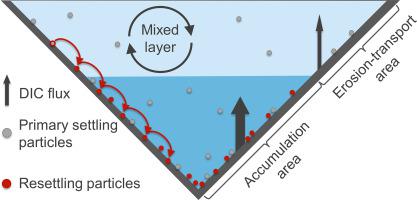Marine Chemistry ( IF 3 ) Pub Date : 2021-03-11 , DOI: 10.1016/j.marchem.2021.103963 Madeleine M. Nilsson , Astrid Hylén , Nils Ekeroth , Mikhail Y. Kononets , Lena Viktorsson , Elin Almroth-Rosell , Per Roos , Anders Tengberg , Per O.J. Hall

|
Continental margin sediments receive most of the particulate organic carbon (POC) deposited on the global seafloor, making them crucial locations in the carbon cycle. However, the complex environments in coastal oceans make it challenging to predict the fate of sedimentary organic carbon (OC) in these areas. Here we use data from 21 sites in the Baltic Sea, representing different biological and physiochemical regimes, to explore controls on sedimentary OC cycling. To this end, we combine in situ measured benthic fluxes of dissolved inorganic carbon (DIC; proxy for OC oxidation) with data on sediment properties. In the Gulf of Bothnia, low sedimentary OC oxidation capacities (yearly DIC flux divided by sedimentary POC inventory) were likely caused by a large fraction of terrestrial material in the POC pool, indicated by low sedimentary chlorophyll a content and high (> 10) carbon:nitrogen ratios. The highest OC oxidation capacities were measured at shallow, permanently oxic sites in the Baltic Proper, where bioturbation likely stimulates OC oxidation. The other sites in the Baltic Proper and all stations in the Gulf of Finland displayed increasing OC oxidation capacities with increasing normalised water depth (station depth divided by maximal depth in the basin). This pattern suggests that substantial quantities of POC are shuttled, through repeated cycles of resuspension-redeposition, from shallow erosion-transport (ET) areas to deep accumulation (A) areas. This interpretation was supported by decreasing sediment age and increasing sedimentary inventories of POC and chlorophyll a with normalised water depth. Our calculations indicate that particle shuttling redistributes almost half of the deposited export production from ET areas to A areas in the Baltic Proper, and that substantial amounts of terrestrial organic material are transported through particle shuttling to the deeper parts of the Gulf of Finland and Gulf of Bothnia. Depositional setting and POC origin can thus be central factors in predicting the distribution and fate of OC in coastal and shelf sediments.
中文翻译:

波罗的海系统规模的沉积有机碳的颗粒穿梭和氧化能力
大陆边缘沉积物吸收了沉积在全球海底的大部分颗粒有机碳(POC),使其成为碳循环中的关键位置。然而,沿海海洋的复杂环境使得预测这些地区的沉积有机碳(OC)的命运具有挑战性。在这里,我们使用来自波罗的海21个站点的数据(代表不同的生物学和物理化学机制)来探索对沉积OC循环的控制。为此,我们将原位测量的溶解性无机碳底栖通量(DIC; OC氧化的代表)与沉积物特性数据结合在一起。在博特尼亚湾,低沉积碳OC氧化能力(年DIC通量除以沉积POC存量)很可能是由POC池中大量的陆生物质引起的,这是由于沉积叶绿素含量低所致。一个含量和高(> 10)碳:氮比。最高的OC氧化能力是在波罗的海适当的浅层永久性有氧场所测量的,那里的生物扰动可能会刺激OC氧化。波罗的海适当地区的其他站点以及芬兰湾的所有站点都显示出随着规范化水深(站点深度除以盆地中的最大深度)而增加的OC氧化能力。这种模式表明,通过重复的重新悬浮-再沉积循环,大量的POC从浅层侵蚀运输(ET)区域转移到了深层积聚(A)区域。降低沉积物年龄和增加POC和叶绿素a的沉积物量,为这一解释提供了支持。归一化水深。我们的计算表明,颗粒穿梭将近一半的沉积出口产品从ET区重新分配到波罗的海适当地区的A区,并且大量的地面有机物质通过颗粒穿梭运到了芬兰湾和墨西哥湾的深处。波斯尼亚。因此,沉积环境和POC来源可能是预测沿海和陆架沉积物中OC分布和命运的主要因素。


























 京公网安备 11010802027423号
京公网安备 11010802027423号